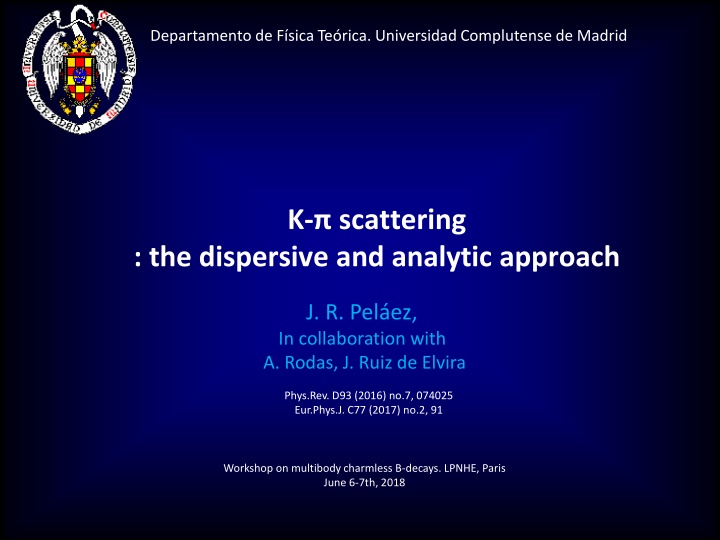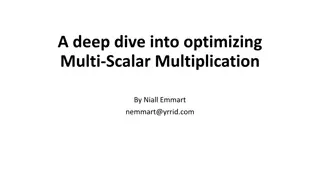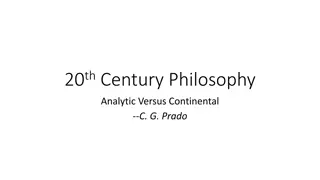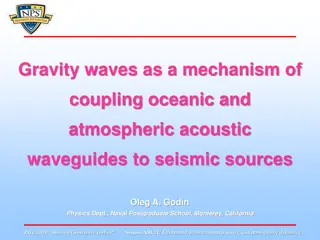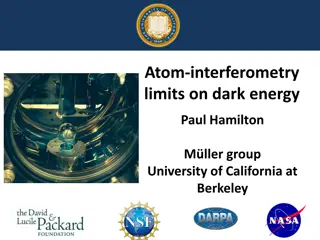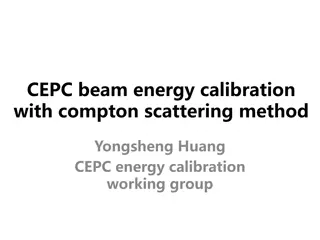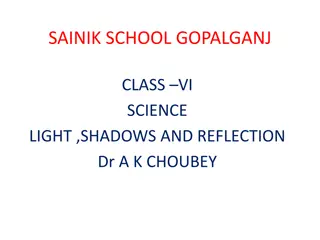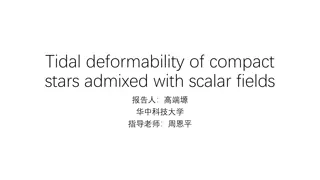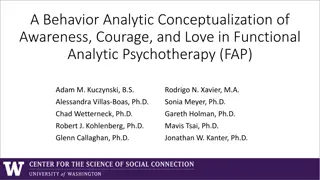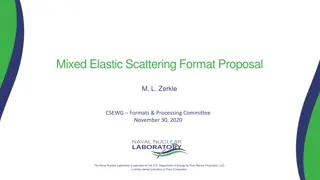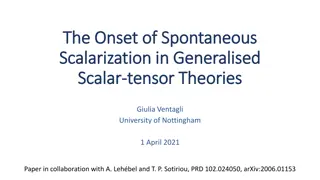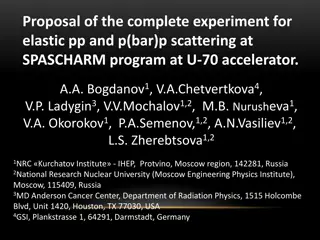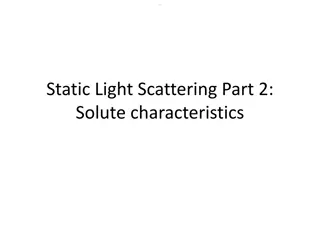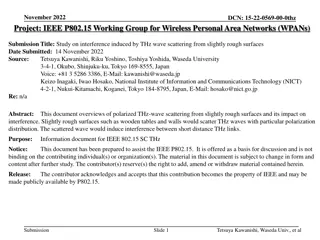Analytic Approach to K Scattering and Light Scalar Controversy
The study of K scattering presents challenges in understanding the nature of resonances like the K0*(800) and implications for strange spectroscopy. The light scalar controversy delves into the classification of scalar mesons and the emerging picture of a light scalar nonet. Analyzing data on K scattering from reliable sources like Estabrooks et al. and Aston et al. underscores the need for rigorous model-independent extractions. Resonances as poles highlight the significance of pole positions and residues in characterizing narrow and isolated resonances.
Download Presentation

Please find below an Image/Link to download the presentation.
The content on the website is provided AS IS for your information and personal use only. It may not be sold, licensed, or shared on other websites without obtaining consent from the author.If you encounter any issues during the download, it is possible that the publisher has removed the file from their server.
You are allowed to download the files provided on this website for personal or commercial use, subject to the condition that they are used lawfully. All files are the property of their respective owners.
The content on the website is provided AS IS for your information and personal use only. It may not be sold, licensed, or shared on other websites without obtaining consent from the author.
E N D
Presentation Transcript
Departamento de Fsica Terica. Universidad Complutense de Madrid K- scattering : the dispersive and analytic approach J. R. Pel ez, In collaboration with A. Rodas, J. Ruiz de Elvira Phys.Rev. D93 (2016) no.7, 074025 Eur.Phys.J. C77 (2017) no.2, 91 Workshop on multibody charmless B-decays. LPNHE, Paris June 6-7th, 2018
Motivation to study K scattering ,K appear as final products of almost all hadronic strange processes: Examples: B,D, decays, CP violation studies, etc ,K are Goldstone Bosons of QCD Test Chiral Symmetry Breaking Many light resonances appear Strange SPECTROSCOPY Particularly interesting for this workshop on Bound States: (800)light scalar meson. needs confirmation @PDG. Light scalar mesons longstanding candidates for non-ordinary mesons. But still some controversy ?/?0
The light scalar controversy. The theory side... classification Scalar SU(3) multiplets identification controversial Too many resonances for many years . But there is an emerging picture (800) A Light scalar nonet: Non-strange heavier!! Inverted hierarchy problem For quark-antiquark f0(980) Singlet a0(980) f0(500) and f0(980) are really octet/singlet mixtures + Another K(1430) + glueball heavier scalar nonet: f0 f0singlet f0 a0(1450) Enough f0states have been observed: f0(1370), f0(1500), f0(1700). The whole picture is complicated by mixture between them (lots of works here) Only the (800) or K0*(800) Needs Conformation @ PDG
Data on K scattering: Most reliable sets: Estabrooks et al. 78 (SLAC) Aston et al.88 (SLAC-LASS) I=1/2 and 3/2 combination No clear peak or phase movement of ?/?0 (800) resonance Definitely NO BREIT-WIGNER shape Mathematically correct to use POLES Strong support for K0*(800) from decays of heavier mesons, but rigorous model-independent extractions absent. Often inadequate Breit-Wigner formalism
Resonances as poles The Breit-Wigner shape is just an approximation for narrow and isolated resonances The universal features of resonances are their pole positions and residues * ????? M-i /2 *in the Riemann sheet obtained from an analytic continuation through the physical cut Im s s-plane Re s
Why use dispersion relations? CAUSALITY: Amplitudes T(s,t) are ANALYTIC in complex s plane but for cuts for thresholds. Crossing implies left cut from u-channel threshold Cauchy Theorem determines T(s,t) at ANY s, from an INTEGRAL on the contour If T->0 fast enough at high s, curved part vanishes Otherwise, determined up to polynomial (subtractions) Left cut usually a problem ?? ?(? ,?) ? ? ?? + ?? ? ?,? = ? Good for: 1) Calculating T(s,t) where there is not data 2) Constraining data analysis 3) ONLY MODEL INDEPENDENT extrapolation to complex s-plane without extra assumptions
Why so much worries about low energy and CORRECT ANALYTIC STRUCTURE? Analyticity is expressed in the s-variable, not in ?
Why so much worries about low energy and CORRECT ANALYTIC STRUCTURE? Analyticity is expressed in the s-variable, not in ? 2 ?? 2 |s|=?? ? plane (MeV2) ????? zero ?? 7002 8002 8902 0 ?? (?? ??)2 ? (890) (800) ?/?0 Threshold behavior (chiral symmetry) Subthreshold behavior (chiral symmetry Adler zeros) Other cuts (Left & circular) Avoid spurious singularities Important for the ?/?0 (800) Problem shared by lattice! Less important for other resonances
Partialwave vs. fixed-variable Dispersion Relations So, we need to get rid of ONE VARIABLE to write CAUCHY THEOREM in terms of the other one TWO MAIN APPROACHES 1) Integrate one variable and keep the other (partial wave dispersion relations)
Partial Wave Dispersion Relations: General Analytic structure complicated if unequal masses (Circular cuts) For elastic region second Riemann sheet is easy to obtain. Due to elastic unitarity: 1 ???(?) = ??(?) ? S ? = 1 + 2?? ? ? , Recalling ? ? = 2 ? ??(?) The second sheet is then: ???(?) = ? + ??? ??(?) Looking for resonance poles is nothing but looking for a zero in that denominator on the first Riemann sheet accesible with the pw DR The problem is the left (and circular) cut
Partial Wave Dispersion Relations: Unitarized ChPT Unitarized ChPT 90 s Truong, Dobado, Herrero, JRP, Oset, Oller, Ruiz Arriola, Nieves, Meissner, Uses Chiral Perturbation Theory amplitudes inside dispersion relation. Relatively simple, although different levels of rigour. Generates all scalars LEFT CUT APPROXIMATED, not so good for precision: (753 52)-i(235 33)MeV But good for connecting with QCD. Strong hints of non-ordinary nature: Nc behavior mqdependence JRP, PRL. 92:102001,2004 Nebreda, JRP, PRD81 (2010) 054035 0 2 1.75 200 Nc 3 1.5 becomes virtual state - i /2 0.75 Nc 5 400 2 1.25 MN/M3 Nc 10 600 1 i 800 At odds with q-qbar Nc behavior N/ 3 1000 0.5 0.25 400 600 800 10 1000 1200 0 5 15 20 M Nc Virtual state recently found on lattice Dudek,Edwards, Thomas, Wilson, PRL. 113 (2014) 18, 182001 Correct behavior obtained for vectors Both suggest important molecular component
Partial Wave Dispersion Relations: Partial Wave DR -3 Roy-like equations. 70 s Roy, Basdevant, Pennington, Petersen 00 s Ananthanarayan, Caprini, Colangelo, Gasser, Leutwyler, Moussallam, Decotes Genon, Lesniak, Kaminski, JRP, Ruiz de Elvira, Yndurain LEFT CUT WITH PRECISION. PRICE: Infinite set of coupled integral equations. VALIDITY LIMITED at ~1.1 GeV Use data on all waves + high energy . Optional: ChPT predictions for subtraction constants The most precise and model independent pole determinations f0(500) and K0*(800) existence, mass and width firmly established with precision (658 13)-i(278.5 12) MeV Descotes-Genon, B. Moussallam Listed @PDG, but not enough for PDG We have been asked for an independent dispersive analysisto trigger the PDG revision
Two strategies SOLVE equations: (Ananthanarayan, Colangelo, Gasser, Leutwyler, Caprini, Moussallam, Stern ) S and P wave solution for Roy-like equations unique at low energy if high-energy, higher waves and scattering lengths known. (in isospin limit) NO scattering DATA used at low energies ( ? 1 ???) Good if interested in low energy scattering and do not trust data. Uses ChPT/other input for threshold parameter Already followed by Paris group (B. Moussallam et al.) . Most reliable determination so far. Impose Dispersion Relations on fits to data. (Garc a-Mart n, Kaminski,JRP, Ruiz de Elvira, Yndur in) Use any functional form and fit to DATA imposing DR within uncertainties. Also needs input on other waves and high energy. (But you can use physical inspiration for clever choices of parameterizations) THIS IS OUR APPROACH
Partialwave vs. fixed-variable Dispersion Relations So, we need to get rid of ONE VARIABLE to write CAUCHY THEOREM in terms of the other one TWO MAIN APPROACHES 1) Integrate one variable and keep the other (partial wave dispersion relations) 2) Fix one variable in terms of the other (fixed-t, hyperbolic relations )
Fixed-t Dispersion Relations (DR) Simple analytic structure in s-plane, simple derivation and use Left cut: With crossing can be rewritten in terms of physical region Most popular: t0=0, FORWARD DISPERSION RELATIONS (FDRs). (Kaminski, Pelaez , Yndurain, Garcia Martin, Ruiz de Elvira, Rodas ) One equation per amplitude. High Energy part known since Forward Amplitude~ Total cross section Calculated up 1.7 GeV for K (and 1400 MeV for ) JRP, A .Rodas, Phys.Rev. D93 (2016) no.7, 074025 Not directly usable for unphysical sheets but very useful to constraint physical amplitudes up to relatively high energies
Forward dispersion relations for K . Since interested in the resonance region, we use minimal number of subtractions Defining the s and anti-symmetric amplitudes at t=0 u symmetric We need one subtraction for the symmetric amplitude And none for the antisymmetric where ??= ?? 2 2+ ??
Dispersive analysis of K scattering DATA up to 1.6 GeV (not a solution of dispersi n relations, but a constrained fit) A.Rodas & JRP, PRD93,074025 (2016) First observation: Forward Dispersion relations Not well satisfied by data Particularly at high energies So we use Forward Dispersion Relations as CONSTRAINTS on fits
How well Dispersion Relations are satisfied by unconstrained fits Every 22 MeV calculate the difference between both sides of the DR /uncertainty Define an averaged 2 over these points, that we call d2 d2close to 1 means that the relation is well satisfied d2>> 1 means the data set is inconsistent with the relation. This can be used to check DR To obtain CONSTRAINED FITS TO DATA (CFD) we minimize: ?2=? ??+ ???)2 2 (?? ?? 2+ ?3/2 2+ 2+ ?? 2 + ?1/2 ??? ? 2 FDR s Sum Rules threshold Parameters of the unconstrained data fits W roughly counts the number of effective degrees of freedom (sometimes we add weight on certain energy regions)
From Unconstrained (UFD) to Constrained Fits to data (CFD) S-waves. The most interesting for the K0* resonances Largest changes from UFD to CFD at higher energies
From Unconstrained (UFD) to Constrained Fits to data (CFD) P-waves: Small changes Our fits describe data well SOLUTION from previous Roy-Steiner approach
From Unconstrained (UFD) to Constrained Fits to data (CFD) D-waves: Largest changes of all, but at very high energies F-waves: Imperceptible changes Regge parameterizations allowed to vary: Only K- residue changes by 1.4 deviations
Consistency up to 1.6 GeV!! Consistency up to 1.74 GeV!!
Summary of this part We have used FORWARD DISPERSION RELATIONS to constraint ?? scattering amplitudes up to 1.6 GeV: Simple parameterizations. Easy to use Still describe data Consistent with unitarity, ANALYTICITY and crossing In progress: We are about to finish the KK Roy-Steiner analysis up to 1.5 GeV Working on the Roy-Steiner analysis for K K. See final slides
Strange scalar resonances from dispersive analysis and analytiicty J. R. Pel ez, A. Rodas, J. Ruiz de Elvira Eur.Phys.J. C77 (2017) no.2, 91 JRP, A. Rodas in preparation
Kappa pole from CFD We have amplitudes that describe data and satisfy dispersion relations up to 1.6 GeV There is also a POLE in the elastic piece of our CFD parameterizations
Kappa pole from CFD 1) Extracted from our conformal CFD parameterization A.Rodas & JRP, PRD93,074025 (2016) Fantastic analyticity properties, but still not completely model independent (680 15)-i(334 7.5) MeV
Kappa pole from CFD: Using Pad sequences A.Rodas & JRP & J. Ruiz de Elvira. Eur. Phys. J. C (2017) 77:91 Almost model independent: Does not assume any particular functional form (but local determination) Based on previous works by P.Masjuan, J.J. Sanz Cillero, I. Caprini, J.Ruiz de ELvira
Kappa pole from CFD 1) Extracted from our conformal CFD parameterization A.Rodas & JRP, PRD93,074025 (2016) Fantastic analyticity properties, but still not completely model independent (680 15)-i(334 7.5) MeV 2) Using Pad Sequences A.Rodas & JRP & J. Ruiz de Elvira. Eur. Phys. J. C (2017) 77:91 (670 18)-i(295 28) MeV Compare to PDG: (682 29)-i(273 12) MeV
Model independent analysis Roy-Steiner SOLUTION from Paris group Decotes-Genon-Moussallam 2006 (658 13)-i(278.5 12) MeV (662 13)-i(289 25) MeV Our Roy-Steiner analysis of FIT to data JRP, A. Rodas, in preparation We have: Constrained Fit to data (not solved) Improved P-wave (data OK) Used Hyperbolic DR both in real axis and complex plane. Improved Pomeron Constrained KK input with DR Other technicalities Independent dispersive determination of the K0*(800)
Summary Dispersion relations have been useful for establishing the existence of resonances and for rigorous determinations of their parameters For light scalars, they have settled the longstanding -meson controversy and are on the way to settle that of the -meson. We have provided first preliminary results for K0*(800) Still in progress: A second dispersive determination with Roy-Steiner and FDRs will finally settle the /K0*(800) issue at the PDG. Our group has been asked to do it. First preliminary results available. Nice agreement with other dispersive aproach We are about to finish the KK analysis needed as input for K K
